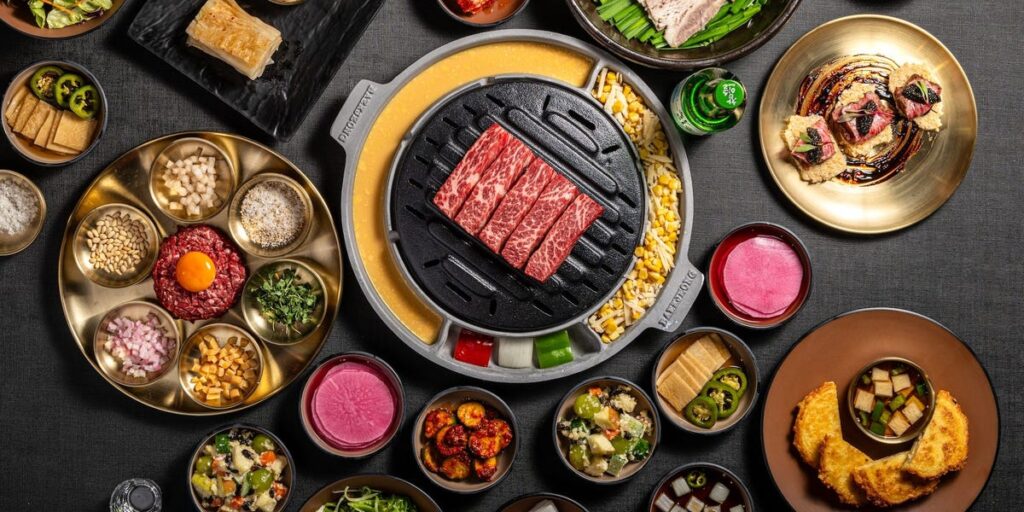After years of cooking in some of New York City’s top kitchens, including Jean-Georges and The Modern, chef Samuel Kim wanted an opportunity that would bring him closer to the Korean food he grew up with.
Kim is now the senior director of culinary operations for Baekjeong, a Korean barbecue restaurant with seven locations in California and Washington — and an eighth opening soon in Los Angeles’ famed Koreatown neighborhood.
“Coming to work here was the first time it really made sense,” Kim told Business Insider. “I’m cooking the food I grew up eating. It’s the food my parents ate. It’s the food I eat when I go home. It’s just who I am.”
Kim hopes that by expanding Baekjeong’s reach, he can share Korean barbecue with more people who’ve never tried it. The chef revealed to BI the KBBQ dishes he always orders (and what to skip) and his favorite underrated dishes.
Now, Kim is sharing tips to help newcomers and Korean barbecue lovers find restaurants that offer the most authentic experience.
All-you-can-eat might be a great deal, but it won’t be the best meal
“Usually, when you go to all-you-can-eat, it’s buffet food,” Kim told BI. “Unless you’re at one of the fancy spots, all-you-can-eat doesn’t usually deliver on the quality or flavor because it’s mass-produced. That’s, for me personally, a red flag.”
“I rarely eat all-you-can-eat,” the chef added. “I understand people are driven by value as opposed to quality; there’s always a market for it. But if you want a truly authentic, flavor-driven Korean barbecue meal, don’t eat all-you-can-eat.”
The meat isn’t cooked in front of you
“If you go to a Korean barbecue restaurant and they don’t cook the meat in front of you, that’s a huge red flag,” Kim said. “One, I question the quality of the meat because they don’t bring it out to you raw and show you. Two, it goes against the custom of Korean barbecue.”
Kim said Korean barbecue has traditionally been a “celebration of the whole community.”
“Everyone would eat around the open fire where they would grill,” he added. “In modern society, we don’t have many opportunities where we eat around the grill, but with Korean barbecue, we’re able to do it at a restaurant and share the experience with the people you’re dining with. It’s that custom of how Korean barbecue became important for us.”
Kim said most Korean barbecue chefs won’t cook the meat from start to finish, letting customers take over grilling responsibilities as part of the “traditional custom.” But at Baekjeong, things are done a bit differently.
“We’ve spent so much time sourcing quality meat; we want to ensure you’re eating the meat when it’s perfectly cooked,” he said. “People wait a long time to get into our dining room because we’re embraced by the community so strongly, so we don’t want you to have to wait and then pay for your meal — and also have to cook it.”
The restaurant feels like a nightclub
“There are some restaurants where you walk in, and it just doesn’t seem like a barbecue restaurant,” Kim said. “Flashing strobe lights and that type of stuff, clearly that model is successful, and to each their own. But, for me, that would be a red flag.”
“Maybe I’m dating myself, and I’m the older generation, but I grew up in Korea and went to high school in Korea, and that’s not what Korean barbecue was for me when I lived there,” he added. “That’s not what it’s about.”
Kim said sharing both a meal and conversation is integral to the experience.
“Korean barbecue, for me, is going to a place where you can see the people you’re eating with,” he said. “It’s not dark, and you can actually hear them.”
“It’s about eating the meat off the grill while having conversations, ordering some beer and Soju,” he added. “It’s like a backyard barbecue you’d have with your friends, but you’re having it in the restaurant.”
Read the full article here
















